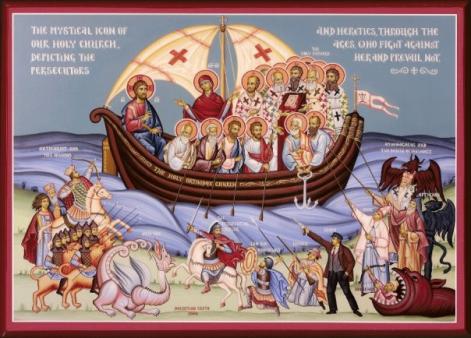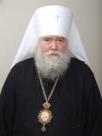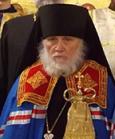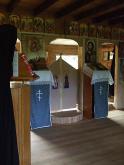Sunday, July 27, 2014
Sermon on the Sunday of the first Six Ecumenical Councils
ORTHODOXY means “right glorification” (of God), correct faith. The correct faith, as defined by the Holy Church - that faith defines how we believe.
The essence of Orthodoxy is NOT things like having gold cupolas, having an iconostasis, having no church seats…! These things are part of Church tradition, and may assist our faith, but they have had various forms in various times and places.
The correct faith was defined at the seven Ecumenical Councils. These gatherings of Bishops discussed and condemned certain teachings which were disturbing Christians at various times in history. These non-Orthodox teachings are called heresies. A heresy is an ERROR in faith, or an incorrect teaching.
These Ecumenical Councils defined the basics tenets (called dogmas) of the Orthodox faith.
In addition to the Councils, the Orthodox faith is informed by the Holy Scriptures (the Bible) and the Church Tradition as taught and lived by the Holy Fathers of the Church.
1. In the 4th century, 300 bishops met and refuted Heresy of Arius against the Son of God.
The Arians believed that Son of God is created, that is, that he is a man and not truly God. They believed that Jesus Christ is NOT equal with God the Father.
It is interesting to note that many modern protestants see Jesus Christ in a similar way to the Arians – as a great moral teacher, a good man, or their personal friend. The manner of addressing God is coloured by this perception of Christ as “one of us, a man”.
Many later Christian Groups, such as MORMONS, the “Church of God”, and Jehovas Witnesses, hold more or less Arian views of our Lord Jesus Christ.
We Orthodox, in contrast, believe that Jesus Christ truly is God AND man.
2. Once again, in the 4th century, 150 bishops met and refuted the heresy of Macedonius against God the Holy Spirit.
The Macedonians believed that the Holy Spirit is NOT equal with God the Father.
This council also reaffirmed the Creed of Faith, which Orthodox Christians recite every day.
It is interesting to note that many years later, the Roman Catholic church changed the Creed of Faith precisely in its explanation of the Holy Spirit. Instead of teaching that the Holy Spirit proceeds from the Father, the Roman Catholic church teaches that the Holy Spirit proceeds from the Father AND the Son – in essence, making the Holy Spirit lower than the Father and the Son.
In contrast, we Orthodox believe that the Holy Spirit is equal with the Father and the Son.
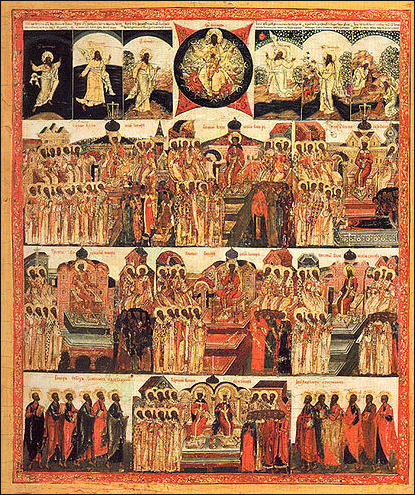
3. In the 5th century, 200 bishops met and refuted the heresy of Nestorius against the Mother of God.
The Nestorians believed that the Holy Virgin Mary should not be called “Theotokos”, but rather, only “Christotokos” – that is, birthgiver of Christ, but not of God. This teaching makes it unclear whether Jesus Christ, from the moment of conception, really was God!
From the beginning of the protestant faiths, they have been reluctant to give the honour of the name “Birthgiver of God” to the Most-Holy Virgin. Many protestants do not believe that the Virgin Mary remained a Virgin before, during, and after childbirth.
In contrast, the Orthodox faith teaches that the Most-Holy Virgin is holier than all the saints, because she fully contained within Herself and gave birth to – GOD the SON!
4. In the 5th century, 600 bishops refuted the monophysite heresy.
The monophysites believed Christ had only ONE nature – the DIVINE nature. They believed His human nature was absorbed in His Divine nature.
To this days, the Coptic “Orthodox”, Syrian “Orthodox”, and Armenian “Orthodox” have not renounced this belief.
The Orthodox believe that Christ had two natures, both Divine and human – otherwise, it would follow that the divine nature suffered on the Cross – something which is not possible for the unchangeable God.
5. In the 6th century, 160 bishops refuted the heresy of Origen.
This belief holds that ‘everyone is saved’ or ultimate universal salvation, regardless of faith and life. It is a very MODERN VIEW of faith, which we encounter every day in the modern society we live in.
The Orthodox faith is very different from this modern indifference – it requires a specific faith, and a specific practice, and sincere repentance wherever a person falls short of the ideal
6. In the 7th century, 170 bishops refuted the monothelite heresy.
The monothelites believed that Christ had ONLY one will - the Divine Will (NOT 2 wills as in Orthodoxy). The famous Saint MAXIMOS the Confessor suffered much, and finally had his tongue cut out because of his stance against this heresy. St Maximos was a simple monk, who taught the correct faith, acting against Emperors, Patriarchs, and Bishops who had accepted the non-Orthodox belief. As he was not even a priest, but only a simple monk, he is an example of what courage, firmness, and knowledge every lay person should have in keeping the Orthodox faith.
7. In the 8th century, 360 bishops met and refuted iconoclasm.
The iconoclasts believed we should not make icons of Christ, the Mother of God, or the saints. This heresy disturbed the Church from more than a hundred years. There were martyrs for the icons, icons were destroyed, and the whole Byzantine empire was implicated.
ALL these Heresies produced thousands of martyrs. Orthodox faithful were killed for refusing to accept these new distorted and altered forms of faith. To this day the TRUE Orthodox Church believes that these Church Councils, through the operation of the Holy Spirit condemned and judged these Heresies, and the ORTHODOX FAITH was defined and confirmed for all time.
YOU are not Orthodox unless you believe according to the Holy Ecumenical Councils. But this is not all – you must also make sure your Bishop believes according to the Seven Ecumenical Councils. This is because the BISHOP is the head of the local Church. How the Bishop BELIEVES is how the Church BELIEVES.
According to the LAWS (the Canons) of the 7 Ecumenical Councils:
1. An Orthodox Christian cannot leave his bishop….EXCEPT if the Bishop is in heresy.
2. An Orthodox MUST, or is obliged to leave his Bishop if he is in heresy.
On this basis people like us left ROCOR(MP) in 2007 when it joined the Moscow Patriarchate (MP), because this organisation fully participates in the World Council of Churches (WCC), and through it, in ECUMENISM – a teaching which has been defined by Church fathers as heresy of heresies.
All the ‘mainstream’ Orthodox bishops who participate in the WCC, and the Churches they represent, do not truly follow the decisions, Canons, ands Laws of the seven Ecumenical Councils. They have signed documents to be ONE with the very heretics condemned by these Councils!
For example, well-known bishops (even patriarchs!) publicly pray with not only Monophysites and Catholics, but also with pagans and Jews. Prayer together with people who believe entirely differently is not allowed for Orthodox people. Therefore, such hierarchs have put themselves outside the Orthodox Church - and no sincere Christian can follow them.
Roman Catholics recognise another 20 Councils as Ecumenical. One of their most recent councils teaches that the Pope of Rome, when he speaks ‘ex cathedra’ is sinless. As mentioned above, they also changed the Symbol of Faith from the 2nd Ecumenical Council.
Protestants and later Christian Sects descended from the Protestants do not acknowledge ANY Ecumenical Councils. This is interesting because the composition of books in Holy Scripture (which they regard as their sole source of authority) was finally decided only in the 6 Century, at the 6th Ecumenical Council (!)
Many of the Heresies of the first Centuries were widespread, lasted a long time, and caused tremendous disruption in Church and political life, with great loss of innocent life. ‘Everyone’ was a heretic. The vast majority of people were in the glorious big churches. The true Orthodox were suffering, persecuted and often tortured and killed, by people who a short while before attended the same church as them!!
The True Orthodox had to gather in Catacombs, and make-do churches anywhere they could.
There is nothing new about the majority being in heresy, and this majority persecuting the few faithful people.
In our times what is most dangerous for us is the entry of Orthodox Churches into the ecumenical movement. This means their acceptance of a Protestant ecumenical understanding of the Church. Such an understanding in reality is already spoken of at meetings and printed in the books of Orthodox ecumenists. Together with the breakdown of an authentic Orthodox understanding of the Church we find an undermining of the meaning of the Ecumenical Councils which means a consequent loss in the firmness of the Council’s dogmas. As a result, the very foundation of Orthodoxy is undermined. ( Protopresbyter Michael Pomazansky. From Orthodox Life, No.1, 1989.)
However, we must understand that the heretic, non-Orthodox Christians are not necessarily “bad people” – but they are not Orthodox. They are not in God’s Church.
We should pray for them and feel sorry for them – bring them to Orthodoxy, by our example faith and life. Those who have left the Orthodox Church, or who entertain non-Orthodox teachings while still outwardly appearing to be “orthodox” are the poorest of the poor – for they have lost their salvation through the Holy Orthodox Church!
Dear brothers and sisters…..we must RUN to the MOTHER OF GOD for help, as the Orthodox Christians always have done.
She will protect, guide and help us. She is our help and Protectress.
Incorrect belief and distortion of Orthodox faith (as defined by the seven Ecumenical Councils), is a spiritual sickness. People who have stopped running to the Mother of God for guidance and help …..eventually end up in incorrect belief, or even no belief or faith. Some even start persecuting the true faith.
Let us pray especially for the younger generations, our children, and their children who will need even more help to survive in our increasingly antichristian world. Amen.
Friday, July 25, 2014
The Troeruchitsa Icon of the Most-Holy Mother of God
Today, the Holy Church celebrates the Icon of the Most-Holy Mother of God called the Troeruchitsa, or “the one with Three Hands”. This Icon has an interesting history.
Akathist to the Troeruchitsa Icon (in Serbian) - parish of St John of Kronstadt in Sydney.
Akathist text in Slavonic (Russian letters)
Akathist text in English
When saint John Damascene functioned as advisor to the Caliph of Damascus in Syria, he once fell into disfavour. This happened because Emperor Leo the Isaurian of Byzantium, the iconoclast, slandered him before the Arab ruler. The Caliph did not understand the internal affairs of Christians, and did not know that Leo actually had left the Orthodox faith. Emperor Leo was now battling against the veneration of icons, and against anyone who defended the Icons. The empire was troubled to an incredible degree - icons were burned and painted over, and brothers fought their own brothers because of the icons. The Orthodox people were forced to pray in make-shift churches and homes, as the iconoclasts took over more and more of the ancient churches. St John was among these pious and persecuted Orthodox Christians.
As a result of this slander, the ruler had St John’s hand cut off. He even displayed the hand publicly in the city as an example for all.
However, with God’s help, friends of St John at the court were able to obtain the cut-off hand. He took the hand to his private prayer chamber, and poured out his grief to the Mother of God. He asked for healing - a healing which would strengthen the Orthodox against the heretic iconoclasts (icon-fighters).
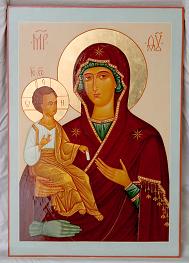 And the Mother of God heard him!
And the Mother of God heard him!
She appeared in a dream to St John. She demanded that he fulfill his promise, now that he had been healed. Seeing the now healthy hand (only a fine line remained where it had been cut off, as a memory), and touched to his innermost parts, St John had a silver hand made, which he fastened to his icon of the Mother of God. This is how it came to be known as the “three-handed” icon.
All of Damascus was similarly amazed, as was the ruler. He loved St John even more than before. Only after a long time he reluctantly allowed St John to leave his service, to become a monk at the monastery of St Savva the Sanctified in Palestine, as he had promised to the Mother of God.
Many years later, St Savva of Serbia arrived at the monastery, and was given this holy Icon as a blessing, as the Mother of God Herself blessed. The Icon remained in Serbia for a long time. However, when unrest arose in the country, it was decided to allow the Mother of God to go wherever She wished. Her Icon was put on a donkey’s back, which was carefully observed to see where She would direct it. Without any kind of intervention from people, the donkey went directly to Mount Athos, where it stopped at the Hilandar monastery. The brothers met the Icon of the Mother of God with reverence.
After the death of the Abbott, the brothers at Hilandar were in discord. However, the Mother of God saved them from internal enmity by taking upon Herself the place of Abbess of this monastery. She did this by repeatedly moving the Icon to the Abbott’s throne in the monastery church - despite the brothers repeatedly moving it back to its usual place. Finally, the brothers understood the Mother of God’s will, and since then to this very day, they do not elect an Abbott, but only a prior (namestnik).
In the 19th centrury, Russian master goldsmiths from St Petersburg made a beautiful riza for the Icon, which also depicts the venerable saint Simeon the Mhyrr-gusher, father of St Savva of Serbia. On the back side of the Icon, there is an icon of St Nicholas.
The Mother of God has saved not only the Hilandar monastery, but also, an innumerable number of Orthodox Christians from every kind of trouble over the centuries. Very recently, the monastery was saved from fire by Her intercession.
Let us pray to the Mother of God, brothers and sisters, to save us from danger, sickness, persecution from outsiders, heresy, and from internal discord! Only by Her help and protection are we able to reach our true home - the Heavenly Jerusalem and the Church triumphant!
Wednesday, July 23, 2014
A mother’s prayer
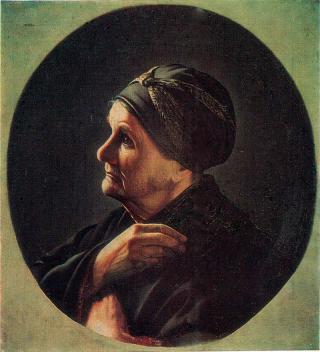 In 1942 I stayed overnight with a poor peasant family in a small village of the Solets region, which at that time was occupied by the German army.
In 1942 I stayed overnight with a poor peasant family in a small village of the Solets region, which at that time was occupied by the German army.
The hostess of the hut was old and ailing, but worked all day. That evening she told me about her sorrow. Four of her sons were at the front, in the Red Army. She missed them very much, and feared that she would never see them again. However, hoping in the endless mercy of the Lord, she prayed for them zealously every day.
That night I heard her Russian, motherly prayer.
I slept in the small room next to her. In the dark of the night, when her husband, the daughter-in-law and granddaughter were fast asleep, she knelt in front of the Kazan Mother of God icon, and started praying in a loud whisper.
I woke up and listened. I realised it was a prayer, and even without meaning to, I “listened in”. Every word was clearly audible. The meaning of the prayer was obvious. The praying woman’s religious mindset was flaming, pure, and deep.
Here is her prayer, nearly word for word. A prayer which impressed itself on my heart.
O Most-pure Mother, Theotokos, Most-Holy Sufferer, Virgin Mary. Hear me, the sinner, calm my motherly soul, fulfil my prayer and safekeep my children’s life – Dimitry, Alexey, Vasily and Ivan. Where are my poor little ones struggling now? Only You know, o Heavenly Queen. Save, keep and return them to me! If it is impossible to return them, then at least return two, or even just one, the youngest little one, Vaniushka. I don’t have anywhere to turn with my sorrow, except to You, o Mother of God…
You are a Mother too! You understand my motherly sorrow!
You also sorrowed and suffered, when You saw the sufferings of Your Son, Christ our God, on the Cross. What did Your soul not experience when they tortured Your Son, spat Him in the face, and beat Him with a stick on the head…?
My dear! John the Theologion lovingly took You into his home when You returned from Golgotha after the death of Your Son, Who was crucified on the Cross for us sinners…
But now we crucify Him again with our sins, we spit on His face again, and beat Him with a stick on the head again, and tear apart Your motherly heart!
The Lord was right…! He is right to punish the Russian people so harshly. He is calling us to repent and to be purified by sorrows.
We should carry our sorrows with patience and humility, in order to receive forgiveness, and lighten the sufferings of Your Son, and Your sufferings, Mother of God!
If I, the sinner, can do that, if even my sorrows are needful for You, Mistress, then accept them please, as a gift, o Queen of earth and Heaven. If it has to be that my children suffer, in order to redeem the sins of all our people, then take all my four sons….But pray to God for forgiveness for the Russian people, and have pity on all the mothers, who in their tears and motherly sorrows have forgotten about Your Motherly sorrows and Your tears, o Mother of God…!
I did not hear any more – I couldn’t listen any more to what this Russian mother whispered to the Mother of God, quieter and quieter…
My chest filled up with emotion, my heart with compunction, and I started to cry. The whispering on the other side of the wall stopped. Quiet sobbing was heard. The earthly mother prayed to the Heavenly Mother with wordless tears….
The sorrow was diluted into those tears, and imperceptibly turned into a quiet joy.
The black, sorrowful night came to its end, and a sweet, pink sunrise took its place.
In the morning, I reverently kissed the hand of this Russian mother.
She became confused - “what are you doing, Batiushka, what’s this” – and she kissed my hand in return, which I did not manage to pull away in time.
Her face was full of light, calm, clear, with holy eyes.
As she went outside, in an old and shabby coat, a young, clean-shaven and stylish German soldier passed by, and cast a disdainful glance at the poorly clad and beggarly Russian woman.
Then I remembered the words of our Russian poet, Tiutchev:
No understanding and no reverence
In the prideful look of the foreigner
For that which penetrates and mysteriously shines
Through your humble nakedness
Ivan Andreev
Sunday, July 20, 2014
The Glorification of St John of Shanghai and San Francisco (1994)
This video is from the service of Vladyka John’s glorification in San Francisco in 1994.
Vladyka John should serve as an inspiration for us all to be zealous with respect to our faith, to live for eternity rather than for this world. Every minute of Vladyka John’s life was focused on God. God’s reality was for him more real than this life on earth.
To become a saint, we must firstly strive to fulfill all the commandments.
We must repent when we fall short in obeying God’s will, that is, when we do not live up to the law of love, the teaching of Scripture, the tradition of piety and morality of the Holy Orthodox Church. If we do not know clearly what ideal the Scriptures and the Church requires of us, this is an indication that we need to learn, that we have not yet begun a truly Christian life.
We can learn by studying the Lives of Saints, such as the life of Vladyka John - because each Saint fulfilled the Law of God in his own time and his own circumstances. We can also learn by reading the Scriptures, and the writings of the Holy Church Fathers.
By the prayers of Saint John and all our holy fathers, recent and ancient, may we turn our life to this path of pleasing God, which will lead us to true happiness, here on earth, and in eternity!
Saturday, July 19, 2014
6th Sunday after Pentecost.
Thursday, July 17, 2014
The Royal New Martyrs of Russia
Tsar-martyr Nicholas would often repeat the Saviour’s words: “He who endures to the end will be saved” (Mt 24:13)
 At the very same time as the Russian people turned away from their Creator and God, our Lord sent them many righteous people to preach repentance. One of the last ones was St John of Kronstadt. He called sinners to repentance. But did people listen? No…Although a few heard him, St John was slandered by all of Russia, and the majority of people continued in their sinful ways…
At the very same time as the Russian people turned away from their Creator and God, our Lord sent them many righteous people to preach repentance. One of the last ones was St John of Kronstadt. He called sinners to repentance. But did people listen? No…Although a few heard him, St John was slandered by all of Russia, and the majority of people continued in their sinful ways…
Then God gave the Russian land over to great persecution for faith, so that sinners would come to their senses. This served to glorify the faithful and reveal the multitudes of holy New Martyrs! The greatest one of these was the Passion-bearer, the Tsar-Martyr Nicholas.
But what kind of lies did the press not write about the meek Tsar-Martyr and his holy family? The modern-minded militant communists loathed him so much they decided he must be destroyed. Even to this day, history books all over the world slander the Tsar-Martyr as an inadequate person, someone highly unsuccessful, a failure…and yet, before God, he is a holy man, a great example of self-denial, and an intercessor for his people and for all Orthodox Christians.
Why is he a saint? Because he courageously denied himself and voluntarily gave up more than we can imagine. Born in a high position, he died as a captive. Born in glory, he found himself slandered. Born to rule, he found himself pushed around like a criminal, and finally, he who had just recently been in command of a great imperial army was executed brutally by terrorists. The Tsar-Martyr bore all this without complaint. He bore it as a Christian soul - sacrificing himself and all the privileges, power, small and great things that he was used to, all his actual rights, all desires, and his own will… He remained faithful to Christ to the end, and died for Him as a true martyr.
Our own time, the 20th century has given the Russian Orthodox Church Abroad new saints - St John of Shanghai and San Fransisco, and St Philaret of New York. Like the Tsar-Martyr, they lived in a time when people were rejecting God and His holy Church. How did they become saints? By a total transformation of their life. Their life was in Christ, in the Holy Church, and not bound to the earth! This change can only be made by repentance. With repentance, it is possible for each one of us, even today!
In our modern world, where multitudes of Christians have turned away from their God and Creator - let us repent and endure to the end!
Wednesday, July 16, 2014
REPENT. Eldress Myrtidiotisssa of Klissoura
The Mother of God says: REPENT! The world will end if people do not repent!
St John the Baptist said: REPENT! For the Kingdom of God is near!
Christ also started his preaching with repentance…
Repentance is the beginning of a Christian life.
Here is a person who became a saint in the 20th century.
We all have the potential to become saints, if we repent!
Repentance is a personal effort - it is a change of life, a change of mind…
It is the beginning of acquiring the mind of Christ!
The Divine law has become obscured. The modern man who does not believe in God, cannot accept that God exists and that God has revealed His law to mankind. The fallen society tells man that all his base desires and actions are good, and that if he follows his impulses, he is “realising himself”.
In past times, shame told man what was sinful. Society told him what was sinful, and should be avoided. Today, man must read the writings of the Holy Fathers of the Church to learn. He must live in the Church, fully participate in Her life, in Her Mysteries, and Her services, in order to understand. He must fast, humble himself, and pray in order to learn who he is himself, and how far he is from Christian perfection. The Church is a school of repentance. A school which teaches the way to the Kingdom
God will give repentance to the man who forces himself to learn to repent!
The Kingdom of Heaven suffers violence, and the violent take it by force!
(Mt 11:12)
Let us repent, brothers and sisters!
Sts Peter and Paul
Of all the apostles the Church especially lauds Saints Peter and Paul, calling them glorious and all-praised leaders of the apostles. One of the four yearly fasts is also called by the name of one of these apostles and ends on their feast day.
Such great honor is proffered them for their great spiritual labors in the field of preaching the Gospel. Even such a prominent Church Father as St. John Chrysostom hesitates in giving preference to one or the other of them, frequently calling them pillars of the Church. The entire book of the Acts of the Apostles chiefly describes the work of the Apostles Peter and Paul in spreading the Gospel. It is interesting to note that Peter and Paul came from totally opposite wakes of life: Apostle Peter was poor and uneducated, while Apostle Paul came from a wealthy family and had a first-rate education for those times. The grace of God that illuminated both apostles shone forth equally from both of them, which leads one to think that our earthly provenance has no significance in the face of eternity. The words of our Lord Jesus Christ come to mind, that “God is able out of these stones to raise up children unto Abraham” (Luke 3:8).
The holy Apostle Peter, a native of the city of Bethsaida and older brother of the first-called Apostle Andrew, was a man of ardent and impulsive nature, illiterate, a simple and God-fearing fisherman. At the Lord’s first summons he left his fishing nets and followed Christ. The Lord always distinguished Peter for his loyalty: he was a witness to Christ’s Divine glory during the Transfiguration on Mount Tabor, he also witnessed the resurrection of the daughter of Jairus, by God’s will he walked on the waters of the lake of Gennesaret. St. Peter earned the Lord’s favor by being the first, on behalf of the apostles, to confess Jesus Christ as the Son of God. However, Peter’s strong confession of the Lord as the Son of God did not subsequently prevent him from thrice renouncing his Teacher in the night of Judas’ betrayal. But this apostasy of Peter’s was expiated by his sincere repentance, and the Lord reinstated him in his apostolic dignity, as described by the Holy Evangelist John (21:15-17).
By the way, this place in the Gospel where the Lord reinstates Peter in his apostolic dignity, from which he fell through his renunciation, is wrongly interpreted by the Roman-Catholic Church as referring to the supremacy of Peter and the Roman bishops, i.e. the primacy of Roman popes.
After his reinstatement Peter remained steadfast in faith, and on the day of the Pentecost preached an inspired sermon that resulted in the conversion of several thousand people to Christ. His sermons were often accompanied by miracles, which made his words irrefutably convincing. Even the shadow of Apostle Peter miraculously healed the sick (Acts 5:15). Among the other apostles Peter enjoyed the primacy of honor, but not power. All decisions regarding the affairs of the Church he offered for examination to the council of the apostles, which sent him out on a par with other apostles to preach the Gospel, while Apostle Paul even contradicted him on several issues (Gal. 2:11).
Peter made six journeys throughout Asia Minor and wrote two epistles for fortifying the faithful, which are used in church services to this day. After the Dormition of the Holy Mother of God, Peter made his last journey from Jerusalem, traveling through Egypt, Britain, Greece, and arriving in Rome in A.D. 67. Here he converted to Christianity two favorite wives of Emperor Nero, who condemned St. Peter to crucifixion for this and for generally preaching Christianity in Rome.
The holy Apostle Paul (Saul), a native of the city of Tarsus, was a Jew from the tribe of Benjamin, and a Roman citizen by the merits of his ancestors, which was a rare combination at that time. He received a brilliant education in the school of the famous Jewish teacher Gamaliel and was educated as a Pharisee. The ardor of Saul (as he was called before conversion to Christianity) for Jewish law was so great that he hated Christians and persecuted them in all possible ways. He tormented the Church of Christ and was a great persecutor of Christians. But then the grace of God touched even him: on the road to Damascus, where he was traveling to engage in greater tormenting of Christians, the Lord appeared to him and summoned him to serve the Church. And thus from Saul, the persecutor of Christians, in a single moment he turned into Paul, one of the most fervent apostles of Christ. He traveled more than all the others to preach the Gospel. Three times he circled almost the entire Roman Empire. He wrote the greatest number of epistles – 14. He took part in the apostolic council. The holy apostle’s life was spent in constant travels through Asia Minor, Greece, and other parts of the Roman Empire, ending with the city of Rome, where he ended his life in A.D. 67 in the reign of Emperor Nero, being beheaded since he was a Roman citizen. His 14 epistles are comprised in the New Testament (as are the two epistles of Apostle Peter) and are used in church services year-round.
How much faith, love for God and their fellow-men, and loyalty to God’s will lived in the souls of the holy Apostles Peter and Paul! They spread the glad tidings into all the corners of the world, baptizing all peoples, suffering heat and cold, thirst and hunger, persecution and torture, – just to serve the great effort of the salvation of mankind! The entire universe of those days was filled with their preaching. Truly the prophetic words of King David came to pass: “Their line is gone out through all the earth, and their words to the end of the world” (Psalms 19:4).
Protopriest Igor Hrebinka (Bishop Joseph)
Sunday, July 13, 2014
Interview with Vladika Nikon and Hieromonk Roman
Vladika Nikon of Ishim and Siberia speaks of the Christian duty to transcend political and worldly considerations, and attain a truly spiritual, Orthodox world-view. He also speaks of the humility with which modern Christians must approach life, understanding that we are all only beginners in the faith compared the generations of Christians that came before us.
Father Roman was recently tonsured into monasticism by Vladika Agafangel. He speaks about his work as a priest in the Holy Land, and about how he, an Arab by birth, came to serve in the Russian Orthodox Church Abroad.
